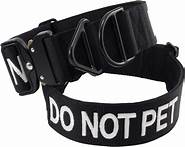Do Not Pet Collar for Dogs: A Guide to Polite Pooch Interactions
Owning a dog is a rewarding experience, but it also comes with certain responsibilities, including ensuring your furry friend interacts appropriately with other people and animals. Sometimes, the best way to achieve this is to use a "do not pet" collar for dogs.

What is a Do Not Pet Collar?
A do not pet collar is a tool designed to communicate to others that your dog should not be petted. It typically consists of a colorful collar or harness with a clear and concise message, such as "Do Not Pet" or "Ask to Pet." By wearing this collar, you are politely informing others that they should not approach your dog without your permission.
When to Use a Do Not Pet Collar
There are various situations where it might be appropriate to use a do not pet collar for your dog. Here are a few common examples:
1. Your Dog is Nervous or Anxious
If your dog is easily startled, shy, or anxious around strangers, a do not pet collar can create a safe space for them during walks or public outings. Wearing this collar can help prevent unwanted interactions that might cause your dog stress or fear.
2. Your Dog is in Training
While your dog is undergoing training, a do not pet collar can help minimize distractions. When your dog is focused on you and learning new commands, being petted by strangers can be disruptive and hinder their progress.
3. Your Dog is Injured or Ill
If your dog is recovering from an injury or illness, wearing a do not pet collar can prevent people from touching or petting them, which can cause pain or discomfort.
4. Your Dog Doesn't Like Being Petted by Strangers
Some dogs simply don't enjoy being petted by strangers. If your dog shows signs of discomfort or avoidance when approached by unfamiliar people, a do not pet collar can help communicate this preference.
Choosing the Right Do Not Pet Collar
When selecting a do not pet collar for your dog, consider the following factors:
1. Clarity of Message
Choose a collar with a clear and concise message that is easy to read from a distance. The message should be large enough to be seen and understood by people of all ages and abilities.
2. Comfort
Ensure that the collar is made from high-quality materials that are comfortable for your dog to wear. Look for a collar that is adjustable and fits snugly without being too tight.
3. Durability
Choose a collar made from durable materials that can withstand regular wear and tear. This is especially important if your dog is active or playful.
4. Visibility
Select a collar in a bright color or with reflective elements to make it easily visible, even in low-light conditions.
5. Personalization
Consider choosing a collar that can be personalized with your dog's name and contact information. This can be helpful in case your dog gets lost or wanders away.
Conclusion
Using a do not pet collar for dogs can be an effective way to communicate your dog's needs and preferences to others. By politely informing people that your dog should not be petted, you can help create a safe and positive environment for your furry friend.
Declaration: All article resources on this website, unless otherwise specified or labeled, are collected from online resources. If the content on this website infringes on the legitimate rights and interests of the original author, you can contact this website to delete it.



